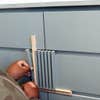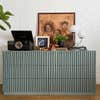An IKEA Malm Dresser Hack That Only Costs $200 (But Looks Like It’s Worth $900)
The secret to the slats? Paint stirrers.
Published Nov 22, 2021 1:25 AM
We may earn revenue from the products available on this page and participate in affiliate programs.
No piece of furniture blends into the background of a white room quite like IKEA’s Malm dresser. The sleek six-drawer piece doesn’t even have hardware (just seamless indentations on the doors). That’s all great news if you’re going for a whole minimalist look or just don’t care because you bought it for your starter apartment anyway. But for DIYer Kayla Nelson, a disappearing act wasn’t what she was after. “I wanted to inject some color, personality, and texture,” says Nelson. Her take on the Malm dresser? Exactly 228 wood slats.
Don’t let that big number scare you. The process (we’ll get to that in a minute) was intuitive, and the final result looks so much more expensive than the original $180 piece. In fact Nelson was partially inspired by a wood dresser with vertical ridges she spotted at CB2 that’s $900. With a touch of green paint, she made the piece completely her own for $200. Ahead, she dives into the step-by-step.
The Supplies
Materials
- ½-inch-thick MDF panel
- Tape measure
- Sandpaper
- Tack cloth
- Angled brush
- Paint tray
- Foam roller
- BIN Primer
- Paint (Nelson used Gray Heron by Behr)
- Level
- Paint mixing sticks
- Liquid Nails
- Drawer hardware
Tool
- Miter Saw
Step 1: Color Your Dresser Pretty
Using a medium, 150-grit sandpaper, lightly sand the entire dresser—a quick once-over to scuff up the surface will do. Clean up any debris with a tack cloth. Coat the surface with the BIN Primer (this product guarantees your paint will adhere to IKEA furniture, which is known for being superslick and chip-prone). Once that’s dry, paint everything with a foam roller to get a smooth finish in the color of your choice.
Step 2: Chop, Chop
Head to your local hardware store or Home Depot and pick up a sheet of half-inch-thick MDF. While you’re there, have the store’s pros cut the board into three rectangular sheets that correspond to the height and width of each row (see the exact dimensions below). Because they won’t be able to make all the individual cuts for you there, each vertical piece will need to be trimmed using your own (or a handy friend’s) miter saw. In total you need 228 slats, as each drawer has 38. The ridges for the top row should be 9 and ⅞ inches tall, while the ones for the middle and bottom row should be 8 and 13/16 inches in height.
Step 3: Pick the Roller Back Up
Lay down a drop cloth, display all your slats, and prime them one by one. Be sure to only cover the three sides that will be visible. Psst: Applying primer to the MDF edges will cause the material to “raise the grain,” or feel rough to touch. “No need to panic, just sand after you’ve primed,” says Nelson. Then paint each one the same color as the dresser.
Pro tip: To avoid the step above altogether, consider painting the MDF while it’s still in panel form, that way it’s not so tedious (that’s Nelson’s only regret).
Step 4: Get Gluing
Starting with the right middle drawer, wedge a paint stick in the center gap between the left drawer and another one below it. Check that the sticks are level. Apply nail glue to the back of your first slat, using just enough to cover the surface area it will share with the drawer (Liquid Nails dries white, so keep a steady hand). Line the slat up flush with the paint stick to your left and the bottom edge of the drawer. This will leave you with a bit of an overhang at the top, but that’s a good thing: It will hide the drawer indentations.
Take two paint mixing sticks and balance them on the right of your newly glued slat and glue on the next slat. “I used paint stirrers, because I was paranoid that I was going to have a weird sliver of space or maybe my math wasn’t going to be correct,” explains Nelson (two paint sticks is the equivalent of ¼ inch). Keep going until you reach the end of the drawer. Repeat for the rest of the fronts, always starting in the center and working your way outward.
Pro tip: Keep the bottom paint stirrer in place for at least 15 minutes as you work your way down the line, that way there is enough time for the fresh glue to dry. “Otherwise, gravity will work against you,” says Nelson.
Step 5: Push to Open
Because the slivers of wood will cover the divots that would allow you to open the drawers, you’ll have to swap the hardware inside to push-to-open versions in order for them to function. Nelson sourced her fresh latches on Amazon (all you need is a screwdriver).








